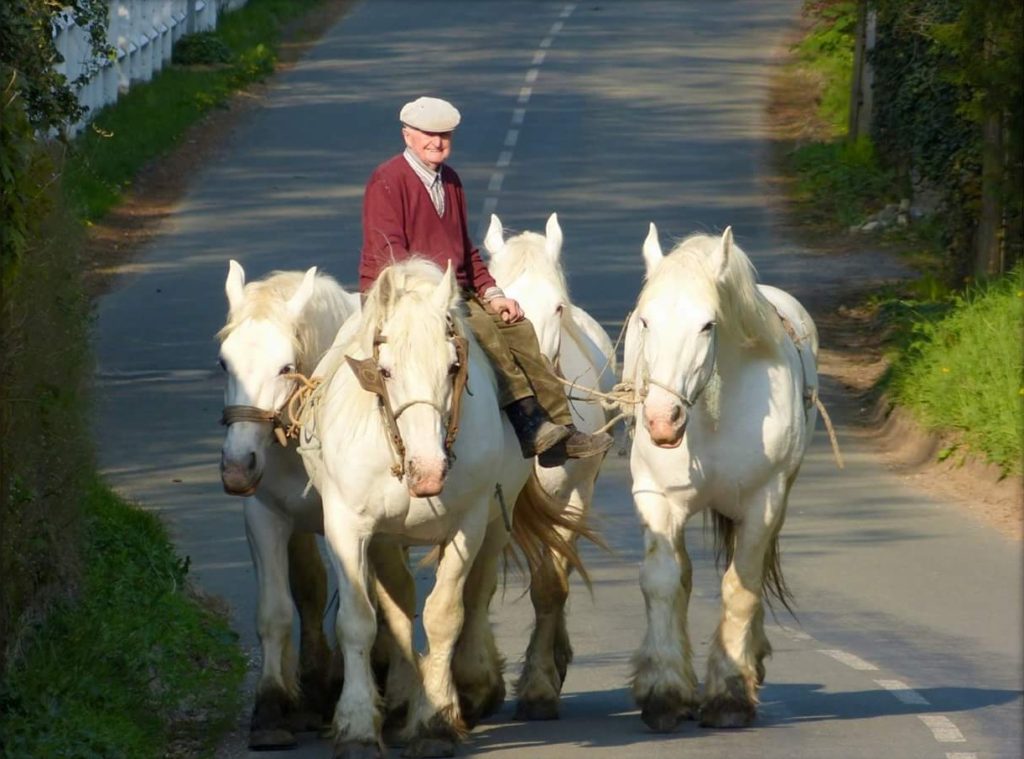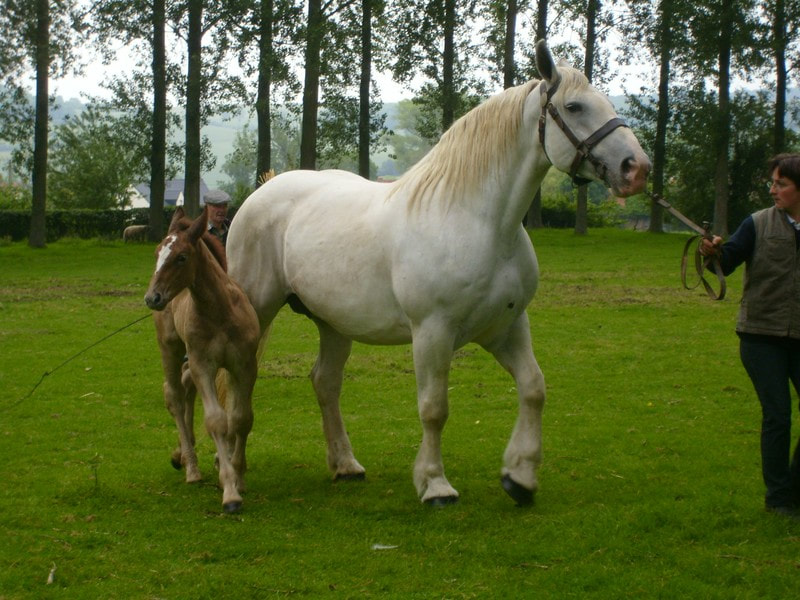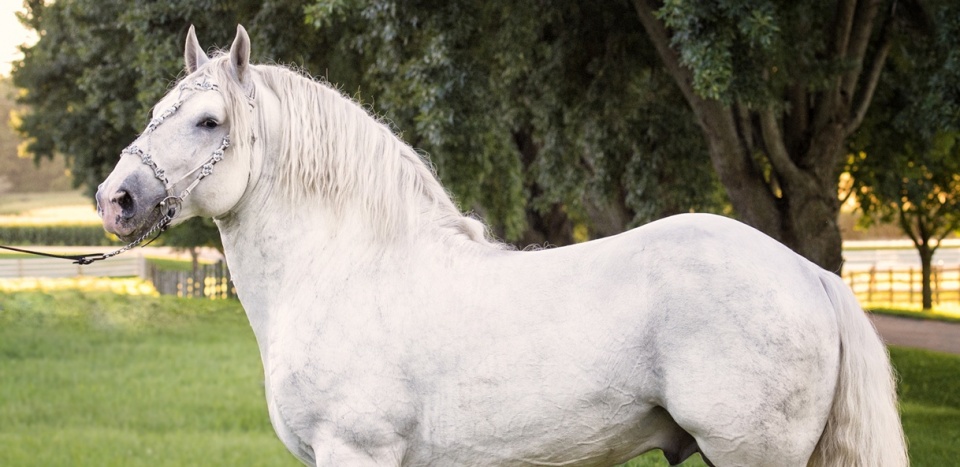The Boulonnais, also known as the “White Marble Horse”, is a draft horse breed. It is known for its large but elegant appearance and is usually grey, although chestnut and black are also allowed by the French breed registry. Originally there were several sub-types, but they were crossbred until only one is seen today. The breed’s origins trace to a period before the Crusades and, during the 17th century, Spanish Barb, Arabian, and Andalusian blood were added to create the modern type.
During the early 1900s, the Boulonnais were imported in large numbers to the United States and were quite popular in France; however, the European population suffered severe decreases during 20th-century wars. The breed nearly became extinct following World War II but rebounded in France in the 1970s as a popular breed for horse meat. Breed numbers remain low; it is estimated that fewer than 1,000 horses remain in Europe, mostly in France, with a few in other nations. Studies as early as 1983 indicated danger of inbreeding within the Boulonnais population, and a 2009 report suggested that the breed should be a priority for conservation within France. The smallest type of Boulonnais was originally used to pull carts full of fresh fish from Boulogne to Paris, while the larger varieties performed heavy draft work, both on farms and in the cities. The Boulonnais was also crossbred to create and refine several other draft breeds.
Breed characteristics

The Boulonnais today stands from 14.3 to 16.3 hands (59 to 67 inches, 150 to 170 cm) or more. It has a short, elegant head with a broad forehead and a short, muscular neck. Members of the breed have full chests, rounded rib cages and sloping shoulders. The legs are fairly short but robust and strong. Unlike other draft breeds such as the Shire or Clydesdale, it has no heavy feathering on its lower legs. The breed is generally branded with a small anchor mark on the left side of the neck. Due mostly to the many additions of Oriental blood, the Boulonnais has an elegant appearance that is not often seen in heavy draft breeds and it has been called “Europe’s noblest draft horse”. The fineness of the skin and delicate appearance of the veins has allowed the horse to be described as looking “like polished marble”, leading to its “White Marble Horse” nickname.
In 1778, the French National Stud performed an initial survey of the breed and found that most were black or dark bay. During the 1800s, grey horses began to appear, and it was the predominating colour by the end of the century. Gray became a popular colour during this time due to the use of the horses to haul fish at night – grey horses were more visible in the dark, and therefore more valuable. In the later years of the 20th century, breeders again began to prefer darker colours such as bay and chestnut. Today, chestnut, grey and black are the only colours allowed by the French breed registry, with the vast majority of horses being grey – a popular phrase says that the horses have coats “the colour of the clouds from the coast”.
History

One theory states that the origins of the Boulonnais breed emerged from the crossbreeding of native French mares and stallions brought by the Numidian army in 55–54 BC. However, many equine scholars are sceptical of this theory, and state that, whatever the early origins, the later selective breeding and local climate and soil types had a greater influence on the breed than any early Oriental blood. During the Crusades, two breeders, Eustache, Comte de Boulogne, and later Robert, Comte d’Artois, wanted to create a fast, agile, and strong warhorse for knights to ride in battle. They crossed the existing heavy French stallions with German Mecklenberg mares, similar to modern-day Hanoverians. During the 17th-century Spanish occupation of Flanders, a mixture of Spanish Barb, Arabian, and Andalusian blood was added to the breed, to create the modern Boulonnais. By the 17th century, horse dealers were coming into the Boulonnais district from Picardy and Upper Normandy to buy local horses, which enjoyed a good reputation among breeders. From the late 18th through the mid-19th century, the Boulonnais spread across France and Europe; during this time, the breed increased in size as the Industrial Revolution called for larger horses that retained the active movement of the original type. Beginning in the 1830s, it was proposed to cross the Arabian with the Boulonnais to create a new type of cavalry horse, and in the 1860s, calls were put forth to add Thoroughbred blood for the same reason. However, breeders rejected these calls, stating that using the breed to create cavalry horses would make them poorer draft horses. Breed societies also discouraged crosses between the Boulonnais and the Brabant. In June 1886, a studbook was created for the breed in France, and placed under the jurisdiction of the Syndicat Hippique Boulonnais (SHB) in 1902.
During the early 20th century, the Boulonnais was imported into the United States in large numbers, where it was registered along with other French heavy horse breeds as the “French draft horse”. Breed members in the United States were registered with the Anglo-Norman Horse Association (or National Norman Horse Association) beginning in 1876, an association that was renamed the National French Draft Association in 1885. This association declared in 1876 that the Boulonnais, Norman, Percheron and Picardy breeds were all essentially the same, and should all be known as the “Norman horse”. They later declared that all of the “Norman horses” were in fact “Percherons”, regardless of actual breeding. This was mostly designed to sell mixed breed draft horses to American consumers at higher prices, and the Illinois Board of Agriculture soon ruled that only those Percherons who came from proven Percheron stock were to be registered as such, and all other breeds, including the Boulonnais, were to be considered separately. Boulonnais was exported from France to Austria, although they saw little success there, and breeding stallions were sent to Argentina.
